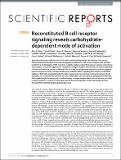Reconstituted B cell receptor signaling reveals carbohydrate-dependent mode of activation
Author(s)
Villar, Rina F.; Weaver, Grant C.; Kanekiyo, Masaru; Wheatley, Adam K.; Yassine, Hadi M.; Costello, Catherine E.; Chandler, Kevin B.; McTamney, Patrick. M.; Nabel, Gary J.; McDermott, Adrian B.; Mascola, John R.; Lingwood, Daniel; Patel, Jinal; Carr, Steven A; ... Show more Show less
DownloadReconstituted b cell.pdf (1.643Mb)
PUBLISHER_CC
Publisher with Creative Commons License
Creative Commons Attribution
Terms of use
Metadata
Show full item recordAbstract
Activation of immune cells (but not B cells) with lectins is widely known. We used the structurally defined interaction between influenza hemagglutinin (HA) and its cell surface receptor sialic acid (SA) to identify a B cell receptor (BCR) activation modality that proceeded through non-cognate interactions with antigen. Using a new approach to reconstitute antigen-receptor interactions in a human reporter B cell line, we found that sequence-defined BCRs from the human germline repertoire could be triggered by both complementarity to influenza HA and a separate mode of signaling that relied on multivalent ligation of BCR sialyl-oligosaccharide. The latter suggested a new mechanism for priming naïve B cell responses and manifested as the induction of SA-dependent pan-activation by peripheral blood B cells. BCR crosslinking in the absence of complementarity is a superantigen effect induced by some microbial products to subvert production of antigen-specific immune responses. B cell superantigen activity through affinity for BCR carbohydrate is discussed.
Date issued
2016-10Department
Broad Institute of MIT and HarvardJournal
Scientific Reports
Publisher
Nature Publishing Group
Citation
Villar, Rina F.; Patel, Jinal; Weaver, Grant C.; Kanekiyo, Masaru; Wheatley, Adam K.; Yassine, Hadi M.; Costello, Catherine E. et al. “Reconstituted B Cell Receptor Signaling Reveals Carbohydrate-Dependent Mode of Activation.” Scientific Reports 6, no. 1 (October 31, 2016). © 2016 Macmillan Publishers Limited, part of Springer Nature
Version: Final published version
ISSN
2045-2322